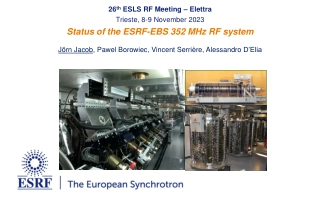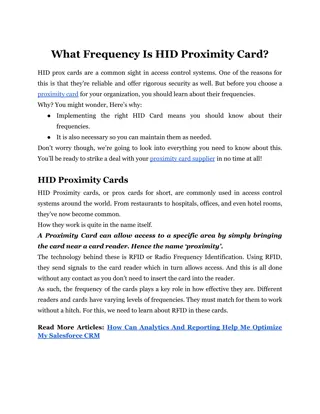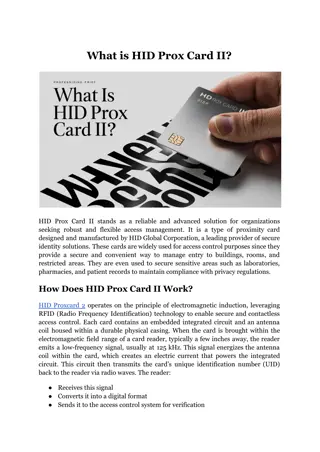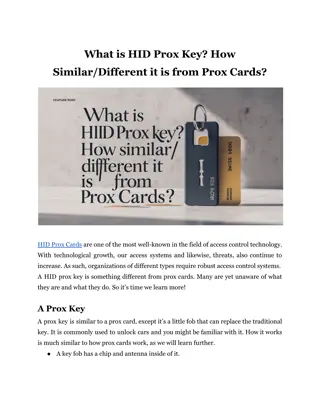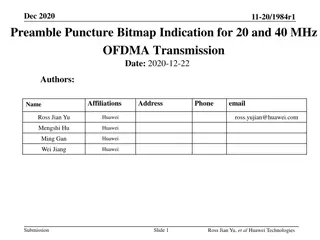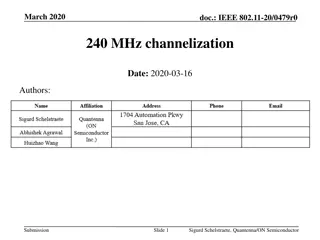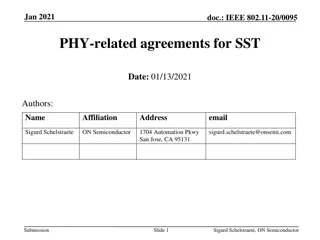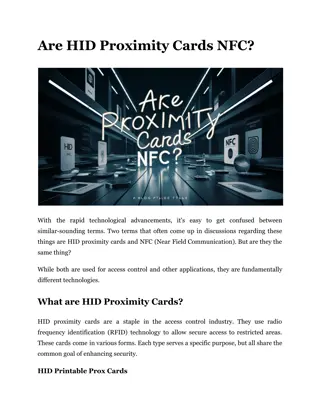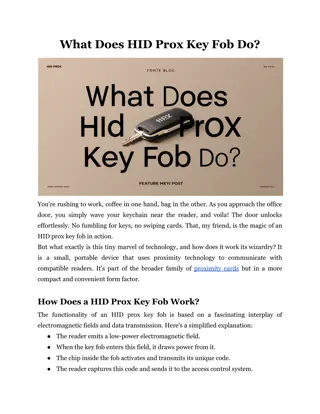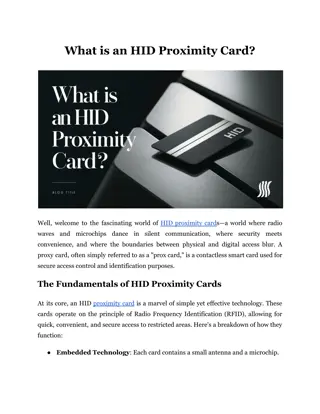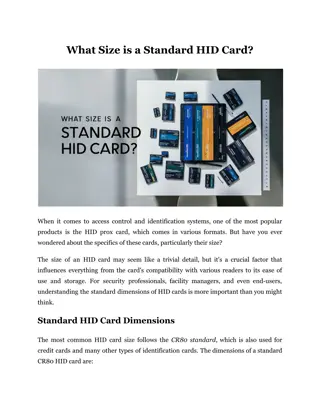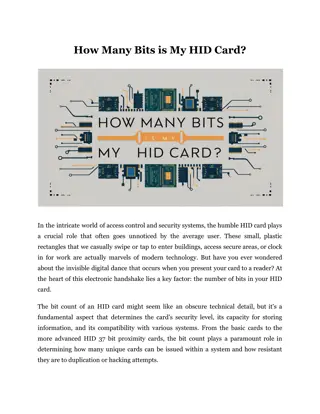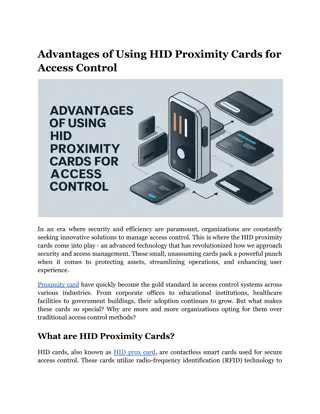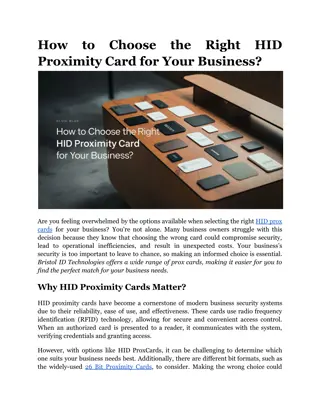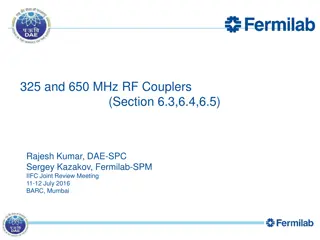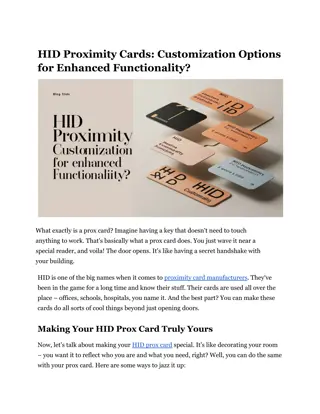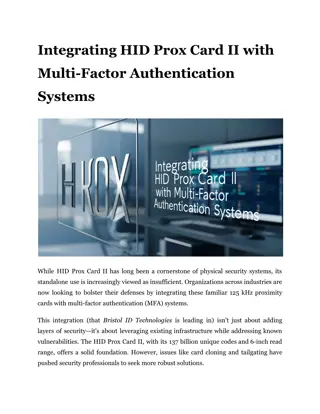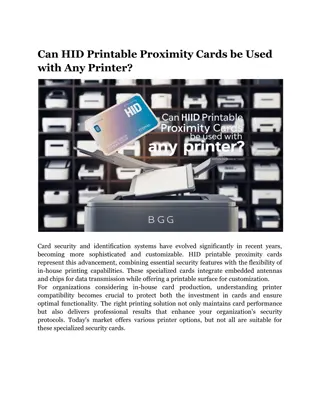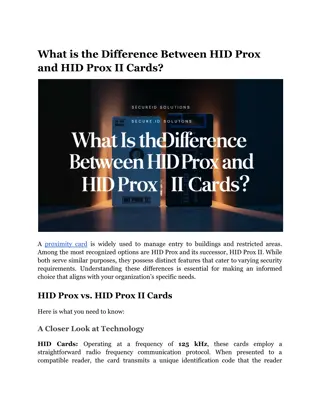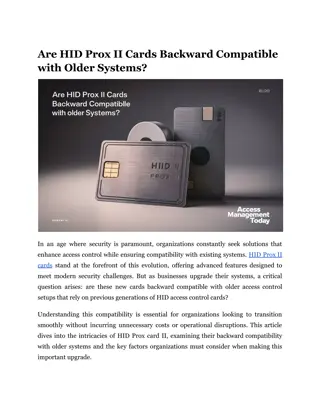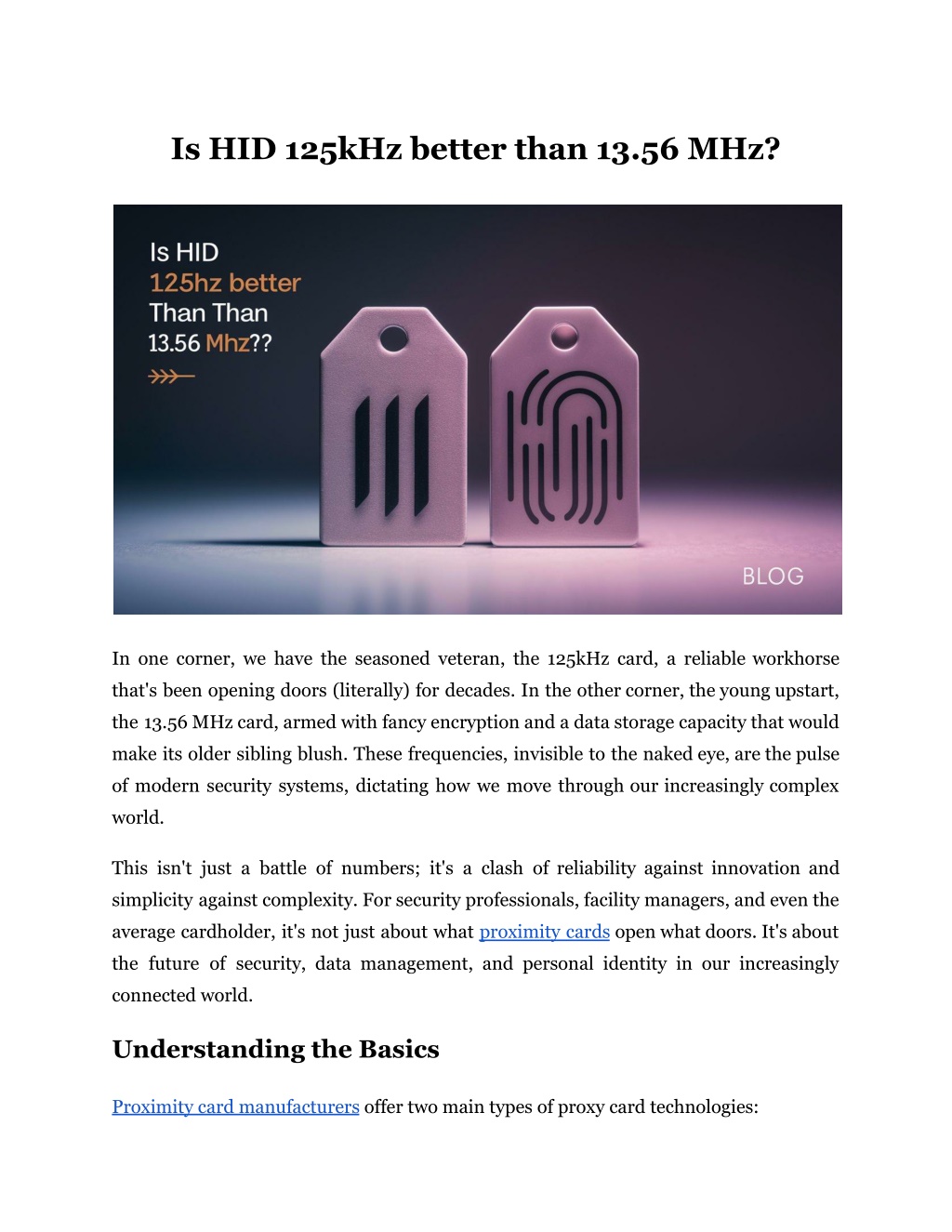
Is HID 125kHz better than 13.56 MHz?
Explore the differences between HID 125kHz and 13.56MHz. Understand which frequency offers better security and performance for your needs.
Download Presentation

Please find below an Image/Link to download the presentation.
The content on the website is provided AS IS for your information and personal use only. It may not be sold, licensed, or shared on other websites without obtaining consent from the author. If you encounter any issues during the download, it is possible that the publisher has removed the file from their server.
You are allowed to download the files provided on this website for personal or commercial use, subject to the condition that they are used lawfully. All files are the property of their respective owners.
The content on the website is provided AS IS for your information and personal use only. It may not be sold, licensed, or shared on other websites without obtaining consent from the author.
E N D
Presentation Transcript
Is HID 125kHz better than 13.56 MHz? In one corner, we have the seasoned veteran, the 125kHz card, a reliable workhorse that's been opening doors (literally) for decades. In the other corner, the young upstart, the 13.56 MHz card, armed with fancy encryption and a data storage capacity that would make its older sibling blush. These frequencies, invisible to the naked eye, are the pulse of modern security systems, dictating how we move through our increasingly complex world. This isn't just a battle of numbers; it's a clash of reliability against innovation and simplicity against complexity. For security professionals, facility managers, and even the average cardholder, it's not just about what proximity cards open what doors. It's about the future of security, data management, and personal identity in our increasingly connected world. Understanding the Basics Proximity card manufacturers offer two main types of proxy card technologies:
125kHz (Low Frequency): Often referred to as HID prox card II Uses older, more established technology Widely adopted and compatible with many existing systems 13.56 MHz (High Frequency): Newer technology Offers enhanced security features Capable of storing more data Both technologies have their place in the market, and the choice between them often depends on specific needs and existing infrastructure. Read More Articles: What is an HID Proximity Card? Comparison Between 125kHz and 13.56 MHz Feature 125kHz (HID Prox) 13.56 MHz (iCLASS) Read Range 2-4 inches 2-4 inches (or more) Data Storage Limited Extensive Security Basic Advanced Speed Very Fast Fast Cost Lower Higher Typical Use Case Simple access control Multi-application A Sneak Peek of 125kHz The 125kHz technology, embodied in HID prox cards, has been a staple in the access control industry for decades. Its widespread adoption means that many existing systems are built around this frequency. Key advantages include:
Compatibility: Works with a vast array of existing systems Cost-effectiveness: Lower cost per card and reader Simplicity: Easy to deploy and manage Speed: Quick read times, ideal for high-traffic areas However, the 125kHz technology does have limitations, particularly in terms of security and data storage capacity. A Sneak Peek of 13.56 MHz The 13.56 MHz technology represents the newer generation of HID proximity cards. It offers several advantages: Enhanced Security: Advanced encryption options make these cards much harder to clone or hack Versatility: Can store multiple credentials or applications on a single card Future-proofing: More adaptable to emerging technologies and security needs Greater Data Capacity: Can store more information, enabling additional functionalities The main drawbacks of 13.56 MHz technology are its higher cost and potential incompatibility with older systems. Practical Applications The choice between 125kHz and 13.56 MHz technologies often depends on the specific application and security requirements. Here are some examples: Corporate Offices: Many businesses opt for 13.56 MHz cards for their enhanced security features and ability to integrate with other systems like time and attendance tracking.
Healthcare Facilities: Hospitals often use 13.56 MHz cards due to their ability to store more data, which can include patient information or staff credentials for accessing different areas. Educational Institutions: Universities frequently use 125kHz HID proximity cards for basic access control due to their cost-effectiveness when dealing with large numbers of users. Government Facilities: High-security government buildings typically use 13.56 MHz or even more advanced technologies due to their superior encryption capabilities. Retail and Hospitality: These sectors often use 125kHz cards for simple access control and time tracking, prioritizing cost-effectiveness and ease of use. Making the Right Choice The decision between 125kHz and 13.56 MHz technology should be based on several factors: Existing Infrastructure: If you already have a 125kHz system in place, switching to 13.56 MHz could be costly. Security Requirements: For high-security environments, 13.56 MHz offers better protection against cloning and hacking. Future Needs: Consider potential future requirements for data storage or multi-application use. Budget: 13.56 MHz systems are generally more expensive to implement. Compliance: Some industries or regions may have specific requirements that favor one technology over the other. Read More Articles: Exploring the Best Wineries in Barossa Valley: A Complete Guide
The Future of Proximity Card Technology As technology evolves, we're seeing a trend towards more secure and versatile solutions. While 125kHz technology isn't disappearing anytime soon due to its widespread adoption, the industry is gradually shifting towards 13.56 MHz and even more advanced solutions like mobile credentials. Some emerging trends include: Hybrid Cards: Combining both 125kHz and 13.56 MHz technologies for maximum compatibility Mobile Access: Using smartphones as credentials, often emulating 13.56 MHz technology Biometric Integration: Combining card technology with fingerprint or facial recognition Choosing Your Security Future So, is HID 125kHz better than 13.56 MHz? The answer isn't straightforward. While 13.56 MHz offers enhanced security and versatility, 125kHz remains a reliable and cost-effective solution for many applications. The "better" choice depends on your specific needs, existing infrastructure, and future plans. As a security professional or decision-maker, it's crucial to assess your organization's unique requirements and consult with experts to determine the best solution. Remember, the goal is not just to choose a frequency, but to implement a comprehensive access control system that meets your security needs today and in the future. Takeaway Whether you need 125kHz HID prox card II for your existing system or want to upgrade to advanced 13.56 MHz proximity cards, Bristol ID Technologies has got you covered. As one of the top proximity card manufacturers, our expert team will guide you through
selecting the perfect solution for your unique needs. Don't compromise on security choose us for innovative, reliable, and future-proof access control solutions! Site Article: Is HID 125kHz better than 13.56 MHz?

